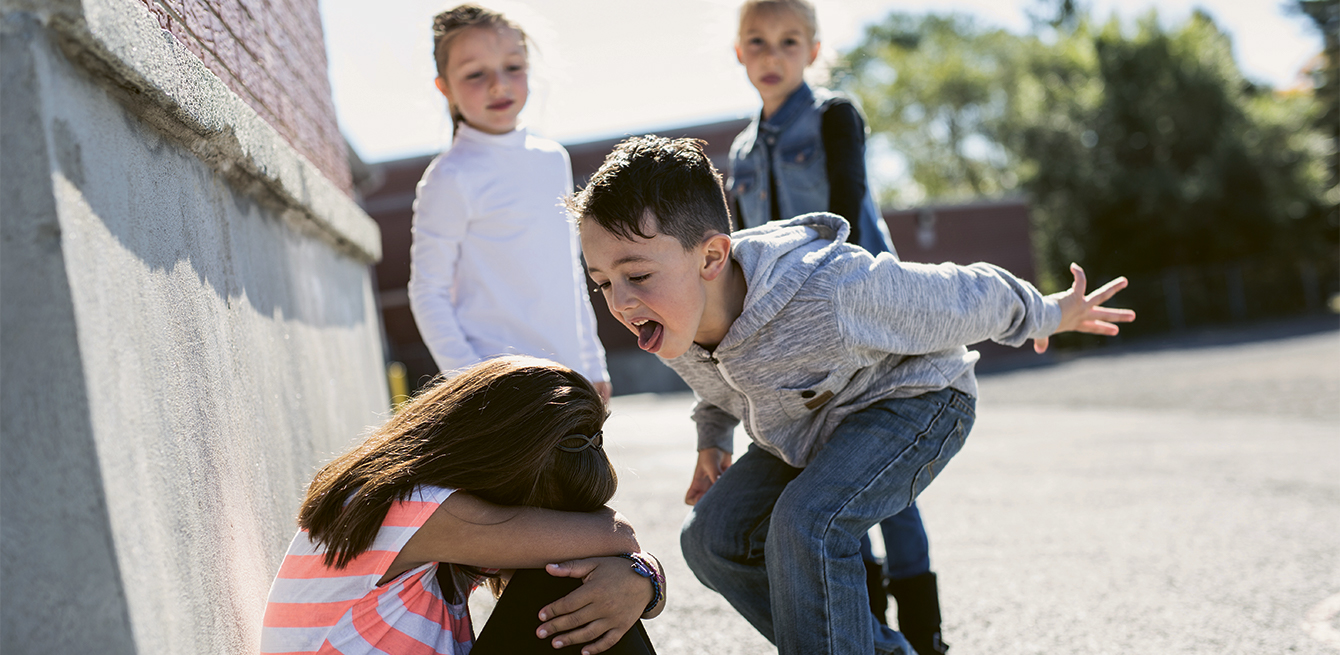
French philosophy professor Jean-Pierre Bellon is a leader in the fight against bullying. He emphasises how important it is for schools to take these matters seriously, at a time when online mockery is growing rampant.
School bullying has become a critical issue for students. The problem has only been aggravated by the rise of social media. Switzerland is no exception. Between 2015 and 2018, the percentage of Swiss youths who have recently been victims of mockery or threats increased from 11% to 13% and from 3% to 7% respectively, according to the latest survey from PISA (the OECD’s Programme for International Student Assessment). How should teachers react to the situation? What effects have lockdowns imposed due to the health crisis had on these students? Answers to these questions and more from Jean-Pierre Bellon, author of several books on bullying.
Bullying has three characteristics: repeated attacks, imbalance of power between the bully and victim, and the target’s inability to defend himself or herself. Theories have long diverged as to the causes of bullying. Some researchers believe that some people are simply aggressive by nature, while another hypothesis, which I agree with, posits that harmful individuals exist, but they wouldn’t do much if they were acting alone. The group amplifies the phenomenon.
No, the trigger is actually relatively unimportant, just as there’s no standard victim profile. Basically it all comes down to hurting someone. There’s no typical profile of victims of traffic accidents or sexual assault. That’s why professionals must stop things early on, as soon as the first rumour or mockery about the student starts.
There are two main reasons. The first is due to ideology. Many researchers have long considered that violence had to be the consequence of social or economic unrest. They didn’t want to see that violence can be strictly school-based and has nothing to do with the external environment. The second reason relates to how people view the role of school. In Scandinavian countries, those leading the fight against bullying have long put priority on the child’s well-being at school. The idea is that a child who is doing well will study well. French school is based on an entirely different model. It is much more disciplinarian. You learn first, then you consider well-being. Due to these two factors, awareness has taken longer in countries such as France, Switzerland and Belgium, which came to this realisation in a similar way.
In small children, the target of bullying and mockery changes all the time. I’m not actually sure that we should call it bullying at this stage. Things become clearer in the teenage years. That’s when the influence of the group is strongest, and being popular becomes all-important. Things then calm down considerably, even though bullying can occur after compulsory school. At this stage, situations, especially cases of cyberbullying, are often serious and exceedingly violent.
I recently assessed a case of cyberbullying as part of a legal suit in Switzerland. I again realised how uninhibited bullies can be when it takes place in cyberspace.
People do things online that they would never do in real life.
Things move in crescendo, with each person trying to one up the other with remarks or taunts. On top of that, attacks linger in time and space, after school, at the weekend or during the holidays. That makes victims even more vulnerable. A 2014 survey showed that victims three times more likely to attempt suicide in cases of cyberbullying.
The main difficulty is that they quickly internalise things: “Why is this happening to me and not to others?” They spontaneously think it’s their fault. And the context often tells them the same thing.
Whether we want to or not, saying that an individual was bullied because they’re a good or bad student, because they’re too fat or too tall, is trying to understand why they’re being bullied. Bullying gets confused with discrimination.
And that confirms what the perpetrators are doing. Victims need to be told very clearly that it’s not their fault, that they were at the wrong place at the wrong time. We should focus on not making victims feel guilty.
I would take this data rather cautiously. You have to make sure that you’re working on the same issues and the same figures. Especially because some questions in the PISA survey look for reasons for bullying, which comes back to the problem I mentioned earlier of turning things against the victim. The Haute École Pédagogique, or University of Teacher Education, has carried out several very specific surveys which show that the situation in Switzerland is not such a disaster. But I also feel that there is an incompressible amount of bullying that will never go away. In 1984, the first survey carried out by researcher Dan Olweous found that bullying involved 10% of students. The latest French study we carried out on school transport estimated a rate of 9.3%.
First, we set up an anti-bullying team at each school, so that any boy or girl who is being bullied knows immediately who to contact for support, a sympathetic ear and kindness. This approach is inspired by the work of Scandinavian researcher Anatol Pikas. In many of the cases I’ve heard, victims did feel that their experience was denied or minimised, that they were left to suffer. Then, the specialised team organises individual interviews with the perpetrators. They are put in a position where they must find solutions to the problem that they helped create, but without ever directly accusing them. The idea is to share a concern with them. For example, we ask them: “This pupil is not well. What can you tell me about that?” It’s very effective. A study led in the Greater Paris region in 2018 shows that more than 80% of the cases handled using this method were resolved.
We observed three points. First, it was an immense break for students being bullied. They realised that they were left alone and didn’t have to go to school in fear. Second, this period also benefited aggressors, who didn’t have to play the role of the mean one that others make them play. Finally, I think that lots of parents realised that school is not some peaceful place with white walls where people spend time moving forward together on the path towards knowledge. They saw first-hand how classes were constantly interrupted by laughter, ringing telephones and all sorts of trouble. Seeing school for what it really is probably makes you think.
No, the phenomenon is consubstantial with the school environment. Gustave Flaubert’s 1857 novel Madame Bovary began with a scene of a pupil being teased in front of his classmates. However, more and more schools these days are dealing with the problem of bullying. I am definitely optimistic, because I have seen an absolutely phenomenal change in the last ten years.

Jean-Pierre Bellon is philosophy professor with the publisher ESF Sciences Humaines. With his colleague Bertrand Gardette, he is one of the pioneers in school bullying prevention in France. He has authored several reference books, including Harcèlement scolaire : le vaincre c’est possible (School bullying: it can be overcome) and Harcèlement et cyberharcèlement : une souffrance en réseau (Bullying and cyberbullying: suffering online).